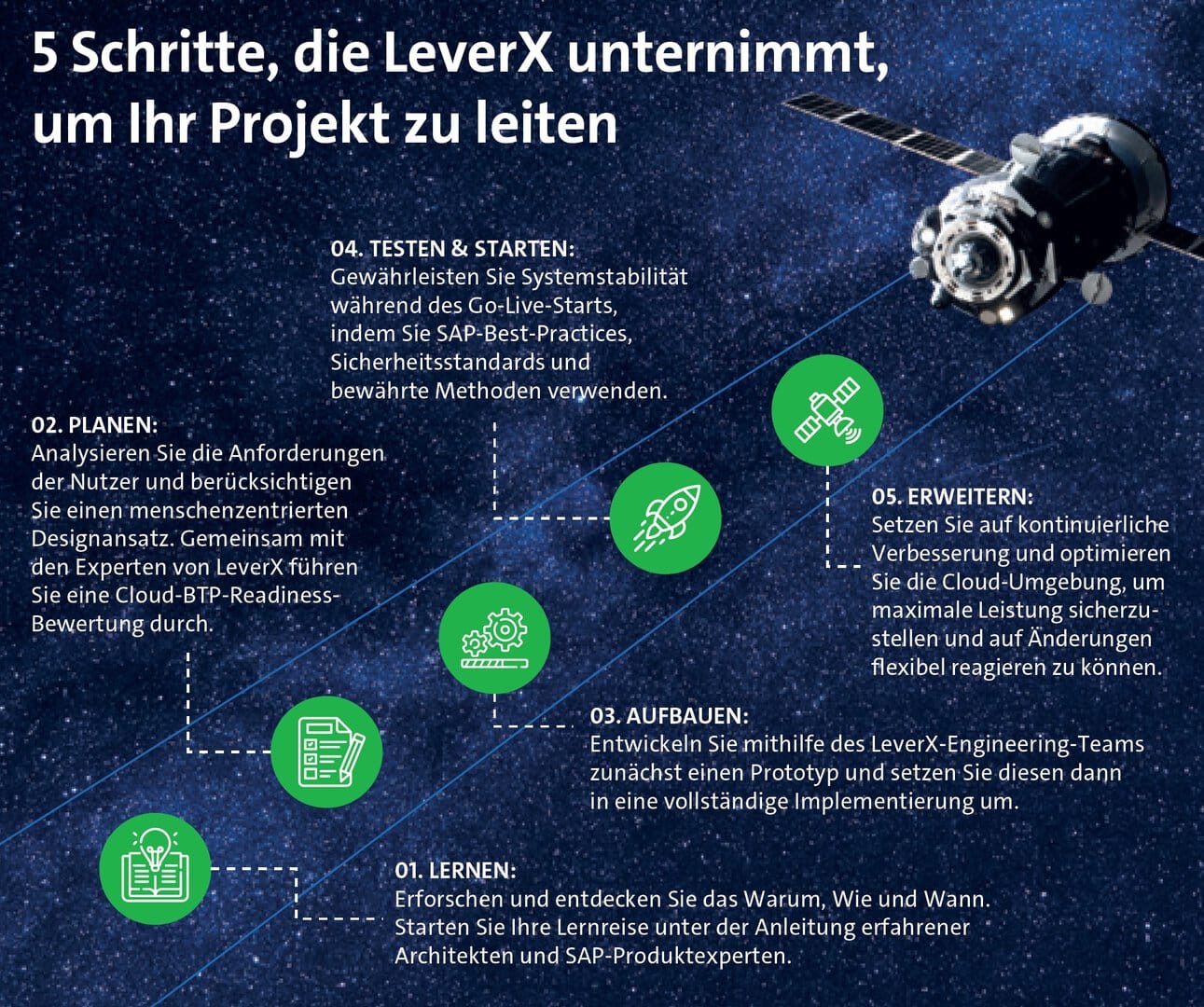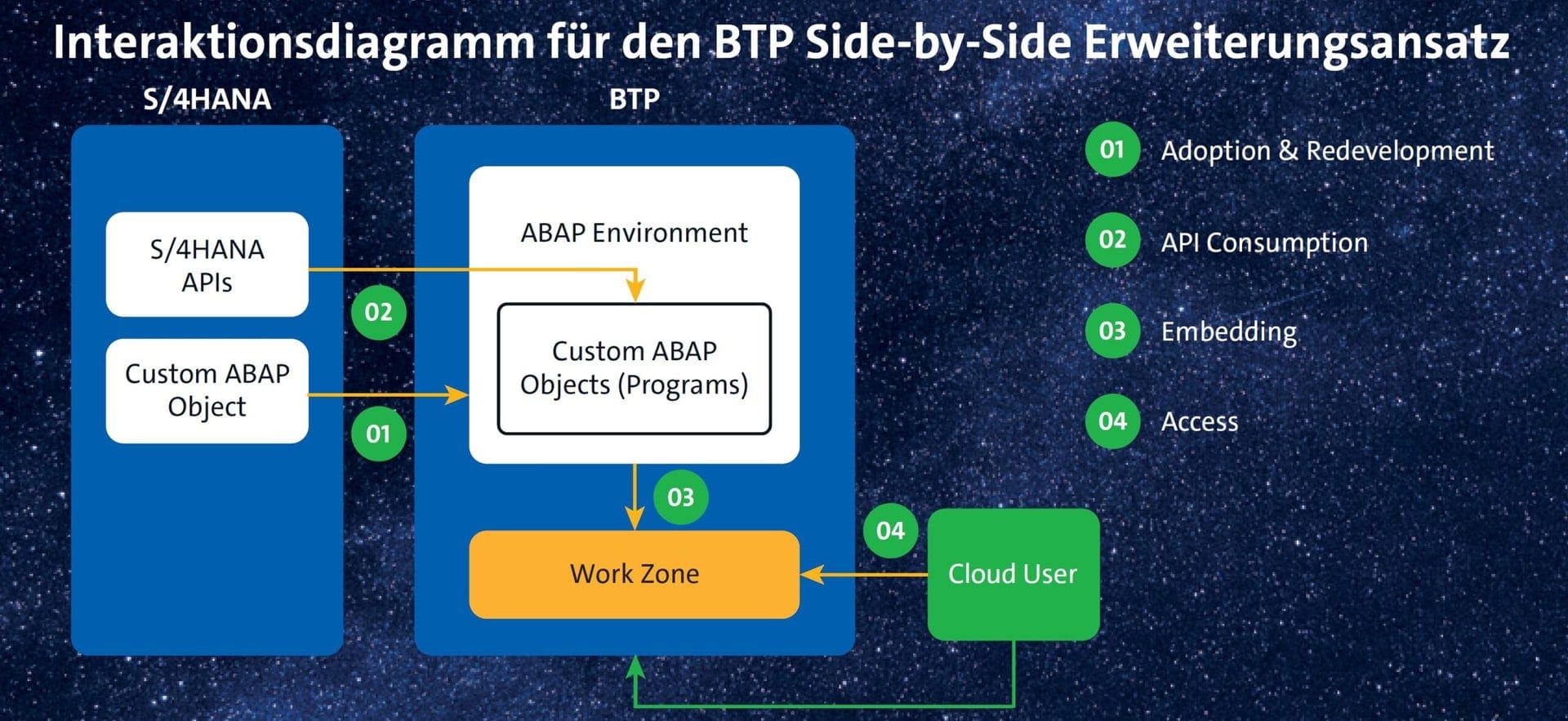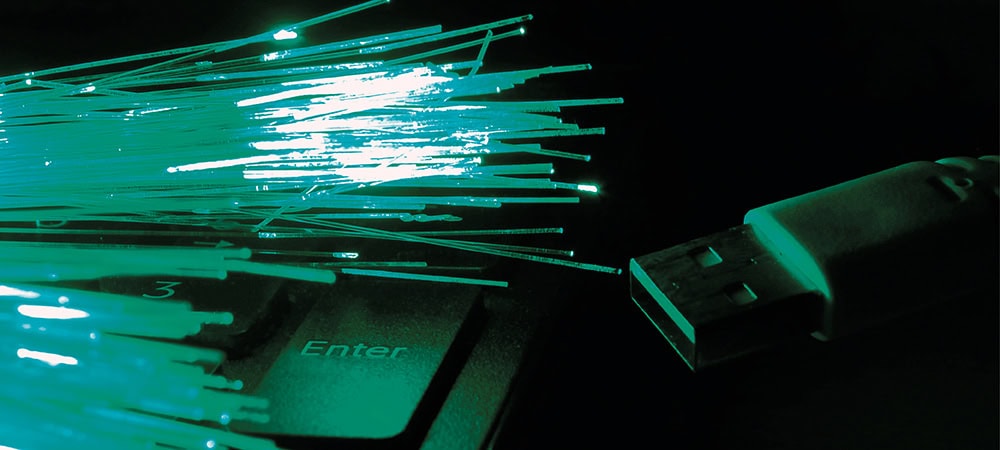Solid Core—Best Practices for S/4 Migration


A successful S/4 migration requires more than just technical expertise. It must take into account the broader framework in which the technology operates. Before we outline the best migration practices, we at LeverX want to highlight the fundamental supporting practices that are equally important for sustainable success.
Effective change management prepares people optimally for the new system, maximizes acceptance and, at the same time, minimizes disruptions so that there are little or no correction costs after the go-live. A human-centered approach ensures that the solutions are intuitive and meet the actual needs of the users, which promotes more efficient workflows and greater satisfaction.
In addition, structured deployment practices—such as transparent release management, thorough quality controls and AI-supported AMS (Application Management Services)—help to keep the project on track and deliver added value in the long term. In addition, LeverX relies on a proven methodology based on key steps that has already proven its effectiveness in the implementation of end-to-end solutions. This methodology is now being applied specifically to clean core initiatives to ensure sustainable and scalable solutions. Insights into best practices for maintaining a clean core during S/4 Hana migration are based on the principles outlined here.
Clean core blueprint
LeverX's methodology for ensuring a clean core and promoting continuous innovation is based on these principles, with an additional focus on customized solutions, efficient governance management, and the use of SAP BTP services. This guarantees that your system will remain agile and future-proof.
The key steps designed to add value and support seamless adaptability on the S/4 Hana journey are: firstly, creating an overview of business issues, challenges and goals; secondly, an in-depth analysis of system code and development practices; thirdly, evaluating the appropriate extensibility scenarios; fourthly, creating the strategy and milestones; and fifthly, ensuring governance and project progress.
Challenges and goals
To gain an overview of the business problems, challenges, and goals, it is essential to conduct a thorough analysis of the client's business landscape as a preliminary step. This process enables the identification of urgent issues, strategic challenges, and key objectives. This assessment allows LeverX to gain a clear understanding of the operational requirements and their alignment with future goals. By examining existing business processes, specific requirements, potential enhancements, and acceptance criteria, the team ensures that the modernization approach is tailored to the client's needs.
The documentation is either revised or newly created to serve as a comprehensive reference for all those involved and to minimize ambiguity. It is equally important to have a clear change management strategy in place, as this can be the determining factor between success and failure.
LeverX uses approaches such as demos, real-life user stories, and use cases to drive adoption and prepare teams for change. The strategy workshop, based on SAP AppHaus' human-centered innovation methodology, supports the development of collaborative and creative solutions, while the enterprise architecture ensures the strategic alignment of technology and business goals. This phase is crucial to lay a solid foundation for the next steps by building a well-aligned and motivated team focused on impactful results.
Analysis of the system code
In the second phase, we conduct a thorough examination of the existing system code and previous software development practices. LeverX establishes transparent objectives and KPIs (key performance indicators) to define success from a technical standpoint. By conducting a comprehensive review of the code base, the team is able to identify areas of inefficiency or outdated code, which in turn allows for optimization opportunities and a reduction in future maintenance efforts. A robust metrics collection system enables continuous performance monitoring, which is essential for maintaining high-quality standards.
LeverX employs a sophisticated framework and specialized software tools, including the ATC (Abap Test Cockpit), to streamline code verification and guarantee compatibility with contemporary platforms. Furthermore, the Custom Code Migration App is employed to facilitate the transition to SAP S/4 Hana. Detailed checks also include the analysis of external APIs and the evaluation of successor objects, which is crucial for grasping the intricacies of dependencies in the integration and potential sources of error.
Allocating sufficient resources and time prevents delays and ensures that all aspects are comprehensively covered. This step lays the foundation for a clean and efficient code base, allowing the system to function optimally and remain easily expandable in the future.
Evaluation of expandability
In the third step, LeverX evaluates the suitability of different extensibility scenarios: side-by-side, key user, and developer extensions. This assessment is important to find the best approach to extend the system while maintaining stability and performance. LeverX experts analyze the strengths and weaknesses of each option and ensure that the selected scenarios meet the customer's requirements and SAP's technical capabilities. The assessment also includes a review of on-stack developer extensibility, published SAP APIs and available integration tools. Regular updates on SAP roadmaps and exchanges with the SAP project teams ensure that the solutions are future-proof and aligned with SAP's long-term strategy.
LeverX also assesses the advantages of SAP BTP services, including potential expenses, to create a comprehensive solution architecture. Proof-of-concept implementations demonstrate the practical applications and feasibility of a solution, thereby reducing risk and showcasing benefits. This is a critical step in selecting the most efficient and sustainable expansion path.

Strategy and milestones
In light of the previous findings, LeverX is now developing a detailed strategy with clear milestones and timelines, prioritizing tasks according to value and urgency. This agile approach allows for flexibility and continuous improvement—crucial in today's dynamic business world. Specific targets for unit testing and test coverage are set to ensure the stability and reliability of the system.
Project metrics help to effectively monitor progress and adjust plans when necessary. Accurate effort estimates ensure optimal and cost-effective use of resources, while proactive risk management strategies minimize potential setbacks. A comprehensive roadmap highlights each milestone and serves as a visual guide to help all stakeholders understand the project direction.
The plan is not fixed but is subject to regular review and adaptation throughout the course of the project in order to respond to new findings or changes in the business environment. LeverX employs a co-innovation model and maintains close collaboration with customer teams. This collaboration fosters a shared sense of responsibility and accelerates the transfer of knowledge, enabling the customer to continue optimizing their SAP environment independently. A well-defined, structured, and flexible strategy allows companies to achieve their modernization goals in an efficient and minimally disruptive manner.
Governance and progresse
The final step focuses on governance and continuous monitoring to ensure the project stays on track and achieves its strategic objectives. LeverX conducts regular consultations to review progress, resolve issues and ensure the project is aligned with SAP's evolving best practices and roadmaps. Regular strategy adjustments ensure that changes in business requirements or technological innovations are quickly taken into account. LeverX ensures that best development practices are followed by using predefined metrics that provide a clear overview of the health of the project.
This strict governance ensures that quality standards are consistently maintained and that any code changes or system updates are well documented and controlled. The co-development model promotes a culture of continuous improvement, with LeverX experts working closely with client teams to drive innovation and maintain progress.
By establishing a robust governance structure, companies can mitigate risk, guarantee timely delivery, and achieve a sustainable transformation that delivers long-term benefits. This step is essential to maintain control and ensure the overall success of the project, with every aspect of the project carefully managed and optimized.

Proven strategy
LeverX's work with a multinational apparel company to create a clean-core foundation is a prime example of how a well-structured strategy, the right approach and industry best practices can turn complex challenges into successful outcomes. The client was struggling to maintain their S/4 Hana system as extensive customizations were making upgrades difficult and driving up costs. The LeverX team quickly identified these issues and emphasized the importance of simplifying and future-proofing the client's processes by adopting SAP's clean-core principles.
BTP workshops
From the outset, LeverX implemented a detailed project plan that began with an intensive workshop to introduce the client's teams to SAP BTP. This was followed by a thorough analysis of the existing Abap extensions and the formation of a specialized team to drive the transformation. LeverX re-engineered custom Abap programs using the Abap Restful Application Programming Model, which significantly increased the performance and scalability of the system. Using SAP BTP's side-by-side enhancement approach allowed the client to modernize the system while maintaining system stability without the disruption previously associated with upgrades.
Downtime during upgrades
The benefits were immediately noticeable and effective. Downtime during upgrades was minimized, maintenance costs were reduced, and the customer's system became more flexible so that it could easily respond to changing business requirements. In addition, the transfer of knowledge to the client's internal teams enabled them to confidently manage and expand their SAP system. The result was a technically superior and cost-effective system that also provided a solid foundation for future innovation and growth. This strategic and collaborative approach demonstrates LeverX's commitment to delivering real, sustainable results for its clients.
Conclusion—why, what, when?
A clearly defined strategy and adherence to best practices are critical to overcoming the challenges of S/4 migration. They help to understand the "why" behind each decision, prioritize the "what" and know the "when" so that each step aligns with long-term business goals. Without this strategic foundation, even the best technologies cannot deliver the desired value.
However, it is also clear that strategy and best practices alone are not enough. The real difference lies in a strong partner who implements these concepts and transforms complex challenges into a clear, sustainable process. With the right expertise and a collaborative partnership, transformation goes from a goal to a lasting reality.






